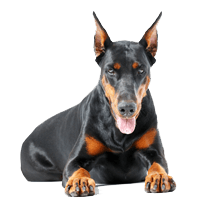
Minor concerns: vWD, demodicosis, osteosarcoma, narcolepsy, gastric torsion, CHD
Avg Size of male: Height: 26 – 28 inches, Weight: 65 – 90 pounds
Note: Blue Dobermans often have alopecia; white Dobermans suffer from several serious health problems.
Major concerns: CVI (wobbler’s syndrome), cardiomyopathy
Occasionally seen: Albinism
Life span: 10 – 12 years
Suggested tests: DNA for vWD, cardiac, (hip)
Avg Size of Female: Height: 24 – 26 inches Weight: 65 – 90 pounds
Brief History on Doberman Pinscher Origin
The Doberman Pinscher is a medium to large sized breed of domestic dog originally developed sometime in 1890 by Karl Friedrich Louis Dobermann, who was just a tax collector from Germany. The Doberman at first impressions is an impressive site. This breed of dog stands on it’s toes, not the pads and it very graceful and quick when it moves. Traditionally the ears of this breed are cropped and posted, and the tail is normally docked. However, in some countries it is illegal to this. In addition to becoming an award winning show dog, the breed proved itself to be exceedingly intelligent and trainable. This intellect, combined with its agility, strength, and protectiveness made the Doberman pinscher a natural choice for military and police work. Since 1976 there has been an albino variation of the Doberman, but in order to discourage the selective breeding of dogs with genetic abnormalities, the Doberman Pinscher Club of America has refused to recognize this variation as acceptable for showing.
Doberman Pinscher Breed Appearance
The Doberman is considered to be living embodiment of sophistication and strength. It is a breed that offers both speed and endurance. The front legs are very straight and somewhat thin in shape with a brawny, muscular appearance. The hind legs are also straight and parallel to one another, giving the Doberman a very balanced and tall look to the breed. The head features a blunt, wedge shape that has almond-shaped eyes with an energetic and insightful expression. The eyes are normally some variety of fawn to brown in color. The ears are traditionally cropped and carried extremely upright. If the ears are not cropped, they end up having a hound-like appearance. The muzzle features powerful jaws with strongly developed teeth. The neck is muscular and blends smoothly into the short, firm back. The tail is usually docked at the second joint, and it is carried slightly above the back when the dog is alert. The gait of this breed can be described as unhampered and balanced.
Doberman Pinscher Breed Temperament
The Doberman is not only adventurous and smart, but it is protective and extremely faithful to it’s family. Making it the perfect breed for a family home. They are alert and want to be challenged mentally and do best with owners that reflect those characteristics. This breed can be aggressive with unfamiliar dogs and people. The Doberman best suited for a family with older, more respectful and understanding children. The reputation of the Doberman Pinscher being dangerous is misleading, under the right care and training these dogs are trustworthy and loyal companions. This breed is known to be focused, fearless, and protective, making for an ideal guard dog. It is extremely important for the whole family to be able to handle this dog in a proper fashion. The Doberman can become pushy and assertive if guidelines are not set. Training is best accomplished through consistent and positive reinforcement. Although the females tend to be slightly more difficult to train. The Doberman can also serve as a extraordinary therapy dog if trained at an early age.
Doberman Pinscher Breed Maintenance
The Doberman Pinscher requires very little coat maintenance. Cleaning them with a cloth or brushing them just a once or twice a week should be enough. Although this breed does require a lot of physical and mental exercise, or it may begin to display frustrated and destructive behaviors. Long walks on a leash around the neighborhood or play in a safe yard are suggested. Apartment dwelling is considered to be okay for this breed, just as long as sufficient exercise is provided to your Doberman. A fenced-in yard is ideal. This breed is sensitive to cold weather and should not be left outside for long periods of time in cold climates or cold seasons. Obedience training should begin at an early age to avoid unwanted behavioral issues later on, and Doberman Pinscher puppies should be handled by a number of people to encourage good socialization while they are still young.
 Toledo, United States.
Toledo, United States.
